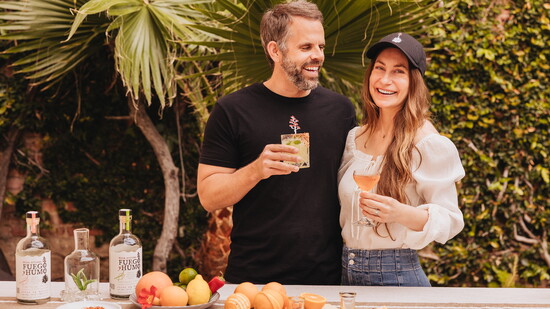A third-generation maestro based in San Dionisio Ocotepec (about 90 minutes southwest of Oaxaca), Jose Manuel Mendez is more than someone who makes mezcal. Fuego Y Humo’s mezcalero is a craftsman, a true creative. His work is earnest and tough—there is no AI tool that will harvest 180 pounds of Tobala or mill by tahona. However, the traditional, artisanal way is what attracted Mendez’s mezcal to Elliott and Karen Reese, founders of Fuego Y Humo.
Fuego Y Humo (“Fire and Smoke”) works with Mendez’s family farm to distribute his mezcal stateside. “If you want to try Jose’s mezcal [in the US], the only way you can get it is under Fuego Y Humo,” Elliott says. “Or you can visit him in Oaxaca.”
There was something that captivated Elliott and Karen the first time they visited Jose. His craft was perfected over time; inherited from both his father and grandparents, the former whom still live on site to help occasionally with the distillation. But it was also his entrepreneurial spirit. “It was very serendipitous that he was ready to take that leap of faith [with his business],” Elliott said. “And obviously, he made great mezcal.”
Mendez is doing something special with agave that has yet to be found stateside. While his business was growing locally—picture a beautifully rustic setting in the mountainous region of Tlacolula, where clear bottles are sold at farmer’s markets or through word of mouth—the Reeses wanted something that would change the conversation around mezcal in the States.
“We’re all about the traditional way that you drink and enjoy mezcal, which is neat,” says Elliott. When the Fuego Y Humo team educates local businesses (like Sama Sama, Augie’s, and Los Agaves) about their mezcal, each varietal—Espadin, Wild Tobala, and Wild Tepeztate—is treated like a wine pairing.
The three varieties have distinctive tastes, ranging from smoky to sweet, which helps broaden people’s understanding of this complex spirit. “It’s a misunderstood spirit,” Elliott says. “Everyone knows tequila, but not many people know mezcal yet.”
As “one of the most complex and beautiful spirits,” according to Elliott, the arduous process for each batch of mezcal begins years before. Mendez often harvests local or wild agave, some of which have grown for three decades, as far as two hours from his home, and brings them back to the family farm, where distilling takes place.
“We hope to keep Jose busy and build the business together,” says Elliott.
For the current batch on Santa Barbara shelves, production was completed in 2022, and the mezcal rested for two and a half years before being released in the US. “It tastes like a dry, hot day in an old western film,” writes a reviewer on Mezcal Reviews.
Sip Fuego Y Humo locally at Sama Sama, Santo Mezcal, Augies, and Los Agaves
fuegoyhumo.com
It tastes like a dry, hot day in an old western film.
Elliot and Karen Reese at Sama Sama. In-house tajin/spice salt. Custom decanter and shot glasses courtesy of Santa Barbara Art Glass.
